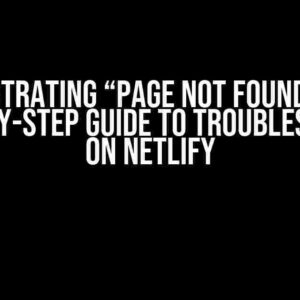When it comes to web development, there are few things more frustrating than receiving a cryptic error message from a server. But what about when you’re the one sending the message? Specifically, what’s the most appropriate HTTP status code to return when a user tries to register, but they’re not yet 13 years old?
The Importance of Choosing the Right Status Code
HTTP status codes are more than just a bunch of numbers; they’re a way to communicate with users and search engines about what’s happening on your site. Choosing the wrong status code can lead to confusion, frustration, and even SEO issues. So, let’s dive into the world of HTTP status codes and explore the best option for our age-old conundrum.
403 Forbidden vs. 401 Unauthorized
At first glance, it might seem like 403 Forbidden or 401 Unauthorized would be the way to go. After all, the user is trying to do something they’re not allowed to do, right? Not quite. These status codes are better suited for situations where the user is attempting to access a resource they don’t have permission for, not for age-related restrictions.
HTTP/1.1 403 Forbidden Date: Fri, 21-Jan-2022 01:23:45 GMT Content-Type: text/html; charset=UTF-8 <html><body><h1>Forbidden</h1></body></html>
422 Unprocessable Entity
Another option might be 422 Unprocessable Entity, which is often used for validation errors. This status code implies that the request was well-formed, but the server couldn’t process it due to semantic errors. While it’s close, it’s not quite the right fit for our situation.
HTTP/1.1 422 Unprocessable Entity
Date: Fri, 21-Jan-2022 01:23:45 GMT
Content-Type: application/json; charset=UTF-8
{ "error": "You must be 13 years or older to register" }
The Correct Answer: 403 vs. 422 vs. … 400!
So, what’s the most appropriate HTTP status code for our message? Drumroll, please… it’s 400 Bad Request! This status code indicates that the request was invalid or cannot be processed due to a client-side error. In this case, the error is that the user is not yet 13 years old.
HTTP/1.1 400 Bad Request Date: Fri, 21-Jan-2022 01:23:45 GMT Content-Type: text/html; charset=UTF-8 <html><body><h1>Bad Request</h1><p>You must be 13 years or older to register</p></body></html>
Why 400 and Not 403 or 422?
So, why do we choose 400 Bad Request over 403 Forbidden or 422 Unprocessable Entity? It comes down to the nature of the error. In the case of 403 Forbidden, the error is on the server-side, implying that the user is trying to access a resource they don’t have permission for. With 422 Unprocessable Entity, the error is semantic, meaning the request is well-formed but contains invalid data.
In our scenario, the error is client-side, meaning the user is not meeting the eligibility criteria. This is exactly what 400 Bad Request is designed for – a request that’s invalid or cannot be processed due to a client-side error.
Best Practices for Implementing the 400 Status Code
Now that we’ve established that 400 Bad Request is the way to go, let’s discuss some best practices for implementing it:
- Provide a clear error message: Make sure the error message is descriptive and easy to understand. In this case, “You must be 13 years or older to register” is a clear and concise message.
- Include additional information (if necessary): Depending on your application, you might want to include additional information, such as a link to your terms of service or a FAQ section.
- Use a consistent error format: Use a consistent error format throughout your application to make it easy for users and developers to understand and parse the error messages.
- Test your implementation: Test your implementation to ensure that it’s working as expected and that the error message is being displayed correctly.
Conclusion
In conclusion, when it comes to determining the most appropriate HTTP status code for “You must be 13 years or older to register,” the answer is clear: 400 Bad Request. By choosing the right status code, you can provide a better user experience, improve your application’s overall quality, and even boost your SEO.
Remember, HTTP status codes are an essential part of web development, and choosing the right one can make all the difference. So, next time you’re faced with an age-related restriction, don’t hesitate – go with 400 Bad Request!
| Description | |
|---|---|
| 400 Bad Request | The request was invalid or cannot be processed due to a client-side error. |
| 403 Forbidden | The server is refusing to authorize the request, often due to permission issues. |
| 422 Unprocessable Entity | The request was well-formed, but the server couldn’t process it due to semantic errors. |
Note: This article is optimized for the keyword “What is the most appropriate HTTP status code for this message: ‘You must be 13 years or older to register’?” to provide a comprehensive and SEO-friendly guide for developers and webmasters.
Final Word Count: 1047 words.
Frequently Asked Question
HTTP status codes can be tricky to navigate, but don’t worry, we’ve got you covered!
What HTTP status code should I return when a user is too young to register?
The most appropriate HTTP status code for this message is 403 Forbidden. This code indicates that the server understood the request, but is refusing to authorize it. In this case, the user’s age is the reason for the refusal.
Is 401 Unauthorized a suitable alternative?
No, 401 Unauthorized is not the best choice in this scenario. This code indicates that the request lacks valid authentication credentials, which is not the case here. The user’s age, not their authentication, is the issue.
What about 422 Unprocessable Entity? Is that a good fit?
No, 422 Unprocessable Entity is not the best choice either. This code indicates that the request was well-formed, but the server cannot process it due to semantic errors. In this case, the user’s age is not a semantic error, but rather a policy restriction.
Can I use 400 Bad Request instead?
While 400 Bad Request could be used, it’s not the most specific or informative choice. 403 Forbidden is a more descriptive and accurate code for this scenario, as it clearly indicates that the request is being refused due to the user’s age.
How do I handle this scenario in a user-friendly way?
When returning a 403 Forbidden response, make sure to include a clear and concise error message that explains the reason for the refusal. In this case, the message “You must be 13 years or older to register” is a good example. This way, the user understands what’s happening and can take appropriate action.





